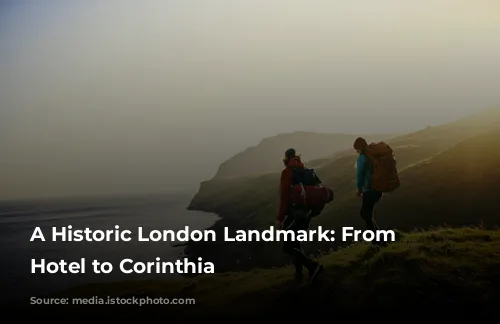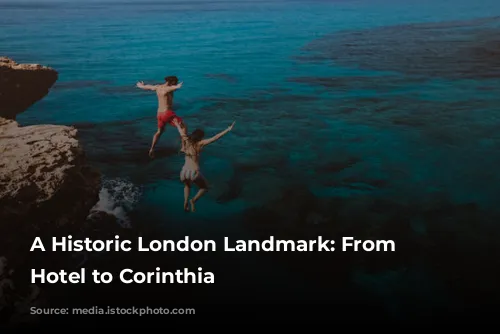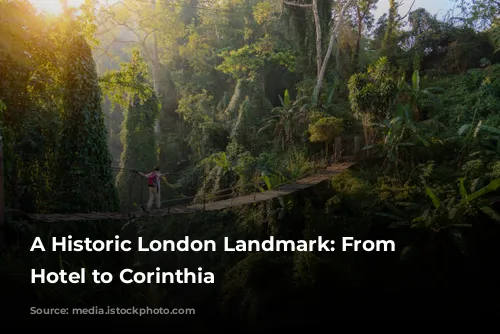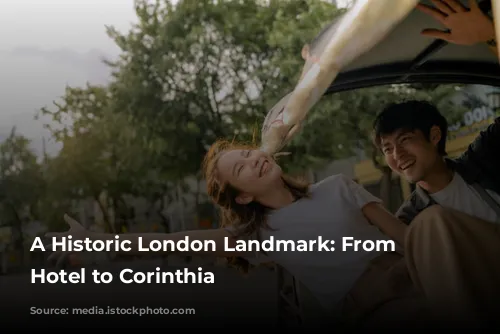In the heart of London, standing proudly at the junction of Northumberland Avenue and Whitehall Place, is a building steeped in history. This grand structure, now known as the Corinthia Hotel London, has witnessed the ebb and flow of the city’s life for over a century. Originally opened as the Metropole Hotel in 1885, its prime location near the Palace of Westminster and government offices in Whitehall made it a natural choice for requisition during both World Wars.
After the Second World War, the hotel was purchased by the Ministry of Defence and served as government offices until its sale to Crown Estates in 2007. This marked a new chapter, with its restoration as a hotel and renaming as the Corinthia Hotel, a unique blend of hotel and residential accommodations.
A Royal Past and the Echoes of War
The Metropole Hotel, conceived by the Gordon Hotels company, opened its doors in 1885 with a lavish 88-page brochure that promised an unforgettable experience. The hotel became a popular gathering place for the elite, hosting annual dinners for prestigious clubs like the Aero Club and the Alpine Club. It was also a central hub for the first London to Brighton run in 1896. The Prince of Wales, later King Edward VII, frequently entertained guests at the hotel, reserving a special box in the ballroom and enjoying the comforts of the Royal Suite.
The onset of World War I saw the hotel requisitioned, becoming a home for government staff alongside other buildings in the area. It was a somber time, with the two Commanders-in-Chief of the British Expeditionary Force, Field Marshals John French and Douglas Haig, staying at the hotel the night before their departure for France in 1914.
After the war, the hotel reopened its doors and quickly became known for its vibrant Midnight Follies cabaret.
A Stage for Entertainment and Sporting Triumph
The Midnight Follies brought a new energy to the hotel, attracting a young, talented musician named Bert Firman. At the tender age of sixteen, he became the youngest bandleader in the world, taking over the orchestra after the previous leader was sidelined. During the interwar years, other renowned musicians like Mantovani graced the stage, adding to the hotel’s reputation as a cultural hub.
In 1936, the hotel witnessed a historic sporting victory. The England Rugby Union team, thanks to a remarkable performance by Prince Alexander Obolensky, defeated the formidable New Zealand All Blacks 13-0. This was a groundbreaking win, with Obolensky’s name etched into rugby history. The England team celebrated their victory at the Metropole, sharing the hotel with their defeated opponents.

From Government Offices to a Modern Icon
By mid-1936, the government’s expansion led them to lease the entire hotel, initially housing the Ministry of Labour and the Ministry of Transport. The Air Ministry and Ministry of Defence later took over, making the Metropole a key government hub. This continued into World War II, with the hotel playing a vital role, becoming a home for various government departments, including MI9 and the Special Operations Executive. It even housed one of the model planning beaches for Operation Overlord.
After the war, the Metropole was transferred to the Crown Estate portfolio and managed by the Ministry of Defence. It served as an overflow building for the main Whitehall complex, with the Air Ministry as a major occupant. From the mid-1960s until 1992, it housed the majority of the Defence Intelligence Staff.
Standing vacant since 2004, the Metropole building and the adjoining 10 Whitehall Place were acquired by a consortium in 2007. The City of Westminster council approved development of the buildings as a hotel and residential complex, giving birth to the Corinthia Hotel London.

A New Era for a Historic Building
The Corinthia Hotel reopened in 2011, offering luxurious accommodations and a spa run by Espa. The building’s rich past was honored with the official announcement of the James Bond movie Skyfall at a press conference held at the hotel in 2011. In 2018, a sequence in the thriller Red Sparrow was filmed both inside and outside the hotel, further cementing its place in modern cinema.
The hotel also hosts a unique Artist in Residence program, inviting writers, theater companies, and filmmakers to showcase their talent. This program continues to keep the hotel connected to the creative pulse of London.
The Corinthia Hotel London is more than just a hotel. It is a living monument to the history of London, a testament to its resilience, and a symbol of its continued evolution. From its grand beginnings as the Metropole Hotel to its current incarnation as a luxurious destination, it has always held a place of importance in the city’s tapestry.










